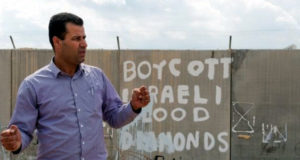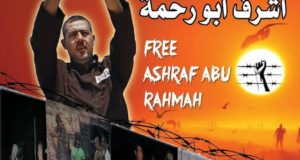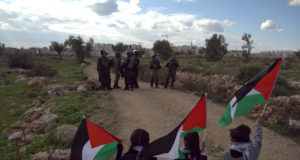By Joy Arbor
Originally published in The Daily Nebraskan
Editor’s note: This is the first of a three-part series on the author’s recent trip to Israel/Palestine.
“Every inch on this land reminds me of memories. These rocks I played with as a child. The trees I planted with my father and grandfather. It makes me sad to see them dying,” said Abu Rani, a 50-year-old man with dark curly hair and a graying beard.
On Nov. 9, we stood under an olive tree in his family’s olive grove. Bright yellow bulldozers and giant cranes were expanding the planned development less than a mile away. At the foot of the slope, between the construction and us, bulldozers cleared what looked like a curvy road.
That road, explained 31-year-old Mohammed Khatib of the Popular Committee Against the Wall in Bil’in, is for the Separation Wall.
Near the West Bank city of Ramallah, Bil’in is a small village of 1,600 residents 2 1/2 miles east of the 1967 Green Line. Two-state solution advocates have hoped that Palestine could forge a state made up of the West Bank and the Gaza Strip. But in Bil’in, 2-plus miles into the West Bank, the Separation Wall built to protect the growing Israeli settlement city of Modi’in Illit is gobbling up over 575 acres, 60 percent of the villagers’ land.
“Fifty people used to live off this land,” said Abu Rani. The wall will divide people from cultivated land on which they have farmed olives and grazed sheep for generations.
The tall buildings of Modi’in Illit create a skyline, its clouds of dust rising into the air. The winds of this valley blow the dust of Modi’in Illit’s expansion into our faces. Khatib claimed the dust harms the olive trees. The gray-green leaves were browning.
Yards away from us were bulldozer tracks. Abu Rani explained that on the feast day after Ramadan, a private company tried to bulldoze the trees. According to a Nov. 25 story in the Israeli online newspaper Ynet, private contractors have uprooted 190 olive trees. The villagers say soldiers do nothing to intervene.
The Defense Ministry told Ynet: “The incident in question was not related to the construction of the security fence, but was the work of a private contractor who was operating in the area.” Villagers claim the police have done nothing.
The world’s eyes have been on Israeli Prime Minister Ariel Sharon, lauding him for the generally peaceful evacuation of the Israeli settlements in the Gaza Strip. But Sharon’s left-leaning critics suspected his motives from the start.
I withheld judgment for a long time. Settlements are always used as facts on the ground to justify military presence, so evacuating the Gaza Strip settlements seemed nothing less than an audacious turnaround of a political agenda from the father of the settler movement.
But seeing the expansion of Modi’in Illit and the lands usurped by the wide barrier loop of the Separation Wall, I have to admit that Sharon, ever the shrewd military strategist, pulled out of the Gaza Strip in order to firm up and expand the holdings in the West Bank.
According to a March 2005 UN report, Modi’in Illit has 27,000 residents. Khatib claimed that far from pulling settlers out of this West Bank settlement, 5,000 new settlers are expected in the next two weeks to move in to a new building. By the time of the writing of this column, those settlers, drawn to Modi’in Illit by the brand-new houses, government subsidies and cheaper housing rates, are probably already there.
A year ago, the International Court of Justice handed down an advisory ruling that Israel’s construction of a wall on Palestinian land violated international law. While the Israeli High Court of Justice disagreed, the September decision did order the military to reroute the Separation Wall in the city of Qalqilia because the Palestinian people were being harmed disproportionately to security needs.
The people of Bil’in are hoping for a similar decision. While their initial appeal to the High Court failed, they have hired a new attorney and are preparing for a new court battle.
Every Friday at noon, Bil’in residents are joined by Israeli and international activists to protest the expropriation of Palestinian land and the building of the wall. Khatib states the demonstrations are intended to be peaceful, but the IDF often uses tear gas and rubber bullets to try to disperse the crowds.
David Pred, an American human rights activist at the protest in Bil’in last Friday, said he stood hand-in-hand with Palestinians, Israeli teenagers and ex-soldiers, and internationals, including a Japanese Buddhist monk. During the demonstration, Pred reports, there was a half-hour sit-in in front of a line of soldiers with a giant bulldozer behind them. The bulldozer finally turned back.
There was little violence during the course of the demonstration, Pred says, but the soldiers did use tear gas.
An online petition to protest the expropriation of Bil’in’s land is available at www.petitiononline.com/Bilin/petition.html. For more information on Bil’in and their struggle against the Separation Wall, go to www.palsolidarity.org.
 International Solidarity Movement Nonviolence. Justice. Freedom.
International Solidarity Movement Nonviolence. Justice. Freedom.


